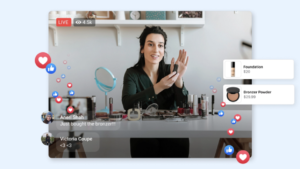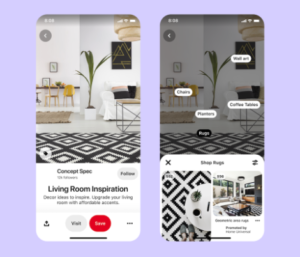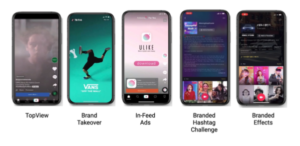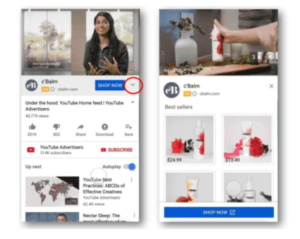The Shoppable Social Boom: Don’t Be Left Behind
Shoppable social has experienced unprecedented growth over the past year playing a key role in how consumers are discovering new products. For example, 81% of consumers are discovering new products on Instagram and 80% are using it to make purchase decisions. The strategic shifts that brands are making to social, in terms of how they view their sales funnel, holds a lot more clout now in terms of Return on Ad Spend (ROAS).
So what does this mean for you, your brand, and your consumers? Let’s explore your options.
What’s the difference? Shoppable Media v. Shoppable Content
More times than not, these terms are used interchangeably, but there is a difference between the two. Shoppable media introduces choice, presenting consumers with the information they need to compare buying options and clear pathways to each retailer.
Shoppable content allows consumers to shop directly from an image, video, lookbook, or online product catalog. After clicking on the product in the content you posted, shoppers are prompted to an online checkout flow either in-app or on your website.
Shoppable Media

Two big names in the shoppable media category are PriceSpider and Destini. These platforms allow shoppers to see where your products are available and buy either directly online from their preferred retailer or at a brick-and-mortar in their desired area.
Shoppable Content
No matter what social channel you’re using, it probably has shoppable capabilities. So whether you are using Facebook, Instagram, Pinterest, YouTube, or even TikTok, you have an opportunity to capitalize on shoppable content.
 On Facebook, any post can be made shoppable. Advancements to their platform, such as the new “Shop” tag, encourage users to discover and shop for brands and products by featuring catalogs and marketplace items. To continue their eCommerce push, Facebook just launched Live-stream shopping events this year, an initiative very similar to the live-stream shopping broadcasts that TikTok has hosted with Walmart. The good news is you don’t have to be a retail giant to have Facebook shopping work for you. We can help with setting up a product catalog and creating shoppable posts and ads throughout Facebook.
On Facebook, any post can be made shoppable. Advancements to their platform, such as the new “Shop” tag, encourage users to discover and shop for brands and products by featuring catalogs and marketplace items. To continue their eCommerce push, Facebook just launched Live-stream shopping events this year, an initiative very similar to the live-stream shopping broadcasts that TikTok has hosted with Walmart. The good news is you don’t have to be a retail giant to have Facebook shopping work for you. We can help with setting up a product catalog and creating shoppable posts and ads throughout Facebook.
 Everyone’s favorite photo app just got even more addictive. There are four ways you can enable consumers to shop in the app with the two main ways being tagging products in posts and stories. By tagging products in posts and stories, you can catch consumers when they are actively engaging with your content.
Everyone’s favorite photo app just got even more addictive. There are four ways you can enable consumers to shop in the app with the two main ways being tagging products in posts and stories. By tagging products in posts and stories, you can catch consumers when they are actively engaging with your content.
An additional convenient way to shop on Instagram is through a brand’s Instagram shop. Your shop can be found on your profile and organized into categories like “New Product Drop,” “Instagram Favorites,” and any other categories that work for your brand.
The other way shoppers can locate and purchase your products is through the Instagram shop tab. Similar to the Instagram explore page, consumers can view shoppable content posted by brands they follow along with suggested content based on previous posts and brands they engaged with.
 Pinterest is commonly used for creating mood boards, but with shoppable content, users can now shop directly from the boards they create. The most common way for users to shop directly on Pinterest is by linking pinned images with the direct product URL. Brands can also create a catalog directly on Pinterest and create a Pinterest Shop. One additional way to create shoppable content on Pinterest is by using a third-party integration. If you are interested in this, you might want to look into SmartCommerc.co, Channel Advisor, BigCommerce-Enterprise, or Destini.
Pinterest is commonly used for creating mood boards, but with shoppable content, users can now shop directly from the boards they create. The most common way for users to shop directly on Pinterest is by linking pinned images with the direct product URL. Brands can also create a catalog directly on Pinterest and create a Pinterest Shop. One additional way to create shoppable content on Pinterest is by using a third-party integration. If you are interested in this, you might want to look into SmartCommerc.co, Channel Advisor, BigCommerce-Enterprise, or Destini.
YouTube
YouTube is currently testing functionality for tagging products in videos, but there are still two great ways you can leverage your YouTube videos for direct sales. Video action campaigns can be seen in home feeds, on the video watch page, or even on Google video partner pages. These ads drive consumers directly to your business, service or product pages. This is a great, cost-effective option that can easily be tracked.
TrueView for Shopping campaigns make your videos interactive. By connecting your Google Merchant Center products to your YouTube channel, shoppers can click to cart via Google Shopping while viewing your video.
TikTok

This app took the world by storm during quarantine and is growing in popularity with brands as more consumers create content on products they love. TikTok has recently joined forces with Shopify, but the two main ways you can use TikTok for direct sales are with ads and promoted hashtag campaigns.
Pre-roll and in-feed are the two types of ads to choose when promoting on TikTok. Pre-roll ads start when the user opens the app. Users have to wait a few seconds in order to scroll. In-feed ads appear natively in the user’s feed. After a few seconds of being on the video, a call to action appears that takes the user outside the app.
Promoted hashtag challenges are probably the most difficult to pull off. To successfully pull off a promoted hashtag challenge, you need to have a hashtag, a unique song, and of course, a challenge that users want to participate in. Pepsi’s #ThatsWhatILike campaign is an excellent example of a promoted hashtag campaign. They had a unique song and hashtag that users wanted to create content for. In fact, the hashtag has 13.5B views, and 2,113 videos were created with their unique song!
What does this mean for your brand?
In 2021, it is projected that there will be 3.78 billion social media users. With that said, the average consumer spends 2 hours and 15 minutes daily on social networking sites. Approximately 28% of the users are using this time to discover new brands and browse products.
This presents a great opportunity for brands to stay relevant with current shoppers and attract new consumers through organic and paid ads. In addition, with 87% of users turning to social media for help in making shopping decisions, it’s essential to create a social presence that is also shoppable when possible.
The fact of the matter is that social media and e-commerce are no longer separated. As they continue to merge, you will need to rethink not only your social media strategy but also your e-commerce strategy. Donovan can help with that. Reach out today for a free consultation to learn how we can help reevaluate your current plan to optimize for the new social media wave of shoppable content.
Source: https://www.thedrum.com/news/2021/06/22/the-rise-social-selling-making-every-touchpoint-shoppable
